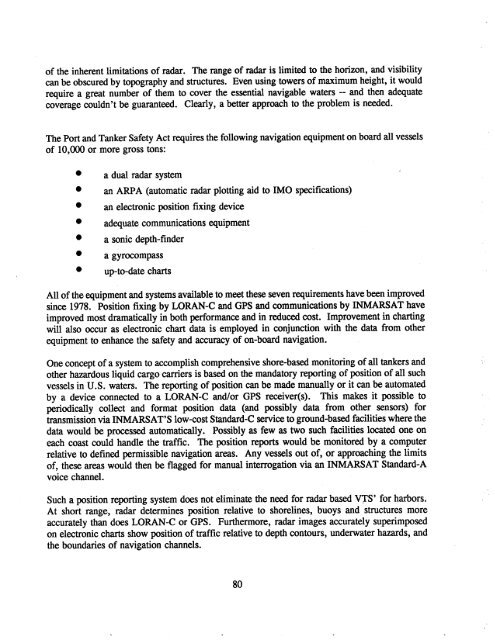WHOI-90-52
WHOI-90-52
WHOI-90-52
Create successful ePaper yourself
Turn your PDF publications into a flip-book with our unique Google optimized e-Paper software.
of the inherent limitations of radar. The rage of rada is limite to the horizon, and visibilty<br />
ca be obscured by topography and structures. Even using towers of maximum height, it would<br />
require a great number of them to cover the essential navigable waters -- and then adequate<br />
coverage couldn't be guarantee. Clealy, a better approach to the problem is neeed.<br />
The Port and Tanker Safety Act requires the following navigation equipment on board all vessels<br />
of 10,00 or more gross tons:<br />
.<br />
.<br />
. .<br />
a dual radar system<br />
an ARPA (automatic radar plotting aid to IMO speifications)<br />
an electronic position fixing device<br />
adequate communications equipment<br />
a sonic depth-finder<br />
a gyrocompass<br />
up-to-date chars<br />
All of the equipment and systems available to meet these seven requirements have been improved<br />
since 1978. Position fixing by LORAN-C and GPS and communications by INARSA T have<br />
improved most dramaticaly in both performance and in reduce cost. Improvement in charng<br />
wil also ocur as electronic char data is employed in conjunction with the data from other<br />
equipment to enhance the safety and accuracy of on-board navigation.<br />
One concet of a system to accomplish comprehensive shore-base monitoring of all taers and<br />
other hazdous liquid cago caers is base on the mandatory reportng of position of all such<br />
vessels in U.S. waters. The reporting of position ca be made manualy or it ca be automate<br />
by a device connected to a LORAN-C and/or GPS reciver(s). This makes it possible to<br />
periodicaly collect and format position data (and possibly data from other sensors) for<br />
transmission via INARSAT'S low-cost Stadad-C service to ground-base facilties where the<br />
data would be procsse automaticay. Possibly as few as two such facilties locte one on<br />
each coast could handle the traffic. The position reports would be monitored by a computer<br />
relative to defined permissible navigation areas. Any vessels out of, or approaching the limits<br />
of, these areas would then be flagged for manual interrogation via an INARSAT Stadad-A<br />
voice channeL.<br />
Such a position reportng system does not eliminate the nee for radar base VTS' for harbors.<br />
At short range, radar determines position relative to shorelines, buoys and strctures more<br />
accurately than does LORAN-C or GPS. Furtermore, rada images accurately superimpose<br />
on electronic chars show position of traffc relative to depth contours, underwater hazds, and<br />
the boundares of navigation channels.<br />
80
















